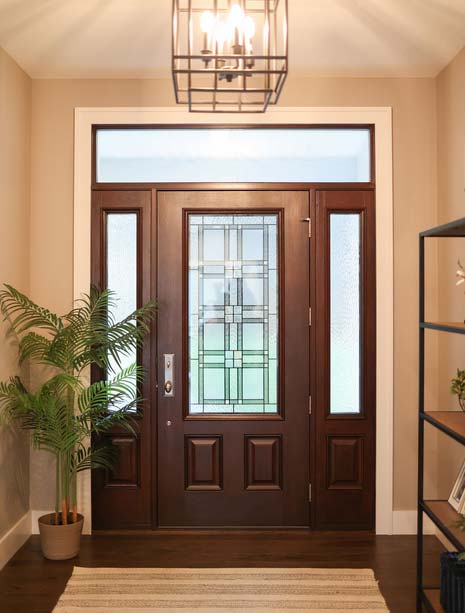Winter in St. Michael, MN, brings with it cold temperatures, snow, and chilly winds. For homeowners, it also means higher heating bills as the furnace works overtime to keep the home comfortable. While windows often receive attention for winter efficiency upgrades, entry doors are another critical element in a home’s insulation. An inefficient entry door can let in drafts, causing heat loss and higher energy costs. In this guide, we’ll explore how to improve the efficiency of your entry doors, reduce heat loss, and increase your home’s comfort this winter.
Why Entry Door Efficiency Matters
Entry doors are a key part of your home’s envelope, the barrier between indoor and outdoor temperatures. During winter, they serve as the first line of defense against cold air and drafts. A poorly insulated entry door can let in cold air, making your home’s heating system work harder to maintain a comfortable temperature.
Benefits of an Efficient Entry Door
- Reduced Energy Costs: An efficient entry door reduces heat loss, saving on heating expenses.
- Enhanced Comfort: Improved door insulation minimizes drafts, keeping your home warmer.
- Improved Durability: Efficient entry doors are often made from high-quality materials that can withstand the elements, increasing the lifespan of the door.
Key Features of an Energy-Efficient Entry Door
When selecting an entry door for maximum winter efficiency, certain features are essential to consider.
Door Material
The material of the door is a significant factor in determining its insulation properties. Common entry door materials include steel and fiberglass, each with different pros and cons for insulation.
- Fiberglass Doors: Fiberglass is an excellent insulator and performs well in cold climates. Fiberglass doors can mimic the look of wood while providing better energy efficiency and resistance to warping.
- Steel Doors: Steel doors often come with an insulating foam core, making them highly energy-efficient and secure. However, they may get cold to the touch in winter if not well-insulated.

Insulated Core
An energy-efficient entry door typically has an insulated core made of materials like polyurethane foam, which adds to the door’s ability to block heat transfer. This core prevents cold air from penetrating the door, keeping the interior warmer. Doors with a solid insulating core provide a significant efficiency advantage over hollow or non-insulated doors.
Low-E Glass Panels
If your entry door has glass panels or windows, look for options with low-emissivity (Low-E) glass. Low-E glass is coated to reflect heat back into your home, improving insulation. Double-pane or triple-pane glass further enhances efficiency by creating air pockets that act as insulation layers.
Tips to Improve Entry Door Efficiency This Winter
While choosing an efficient entry door is a great start, there are also practical steps you can take to enhance the insulation of your current door.
Add a Storm Door
Installing a storm door provides an additional layer of insulation. Storm doors create an air pocket between themselves and the entry door, acting as a buffer against the cold. They also offer extra protection against wind and precipitation, which is particularly beneficial during Minnesota’s winter months.
Apply Insulating Caulk
Use caulk to seal any cracks or gaps around the door frame. Over time, small gaps can form between the door frame and the wall, allowing cold air to seep in. Caulk is an affordable and effective way to seal these gaps, helping to keep your home warmer and reduce energy costs.
When to Consider Replacing Your Entry Door
If your entry door is old, damaged, or frequently drafty, replacing it may be the best option. New entry doors with advanced insulating materials and weatherproofing features offer a long-term solution for improved energy efficiency. Here are some signs that it may be time to consider a replacement:
- Visible Damage: Cracks, warping, or dents can compromise the door’s insulation and make it difficult to maintain a proper seal.
- Persistent Drafts: If you’ve tried adding weatherstripping, a door sweep, and other insulating techniques but still feel drafts, a new door may provide better insulation.
- Condensation on Glass Panels: If you notice condensation or fogging between glass panels, it’s a sign that the door’s seal is failing, which reduces efficiency.
At A Pane in the Glass Construction, we understand the unique needs of St. Michael homeowners when it comes to winter door efficiency. We offer a range of entry doors designed for energy efficiency, style, and durability. Whether you’re interested in upgrading your current entry door or need expert advice on improving insulation, our team is here to help. Enhancing your entry door’s efficiency can make a big difference in home comfort, reduce energy bills, and keep the winter chill at bay. With the right strategies and guidance from A Pane in the Glass Construction, you can enjoy a warmer, more efficient home all season long. Contact us today to explore your options for improving entry door efficiency in St. Michael, MN.Work with A Pane in the Glass Construction
